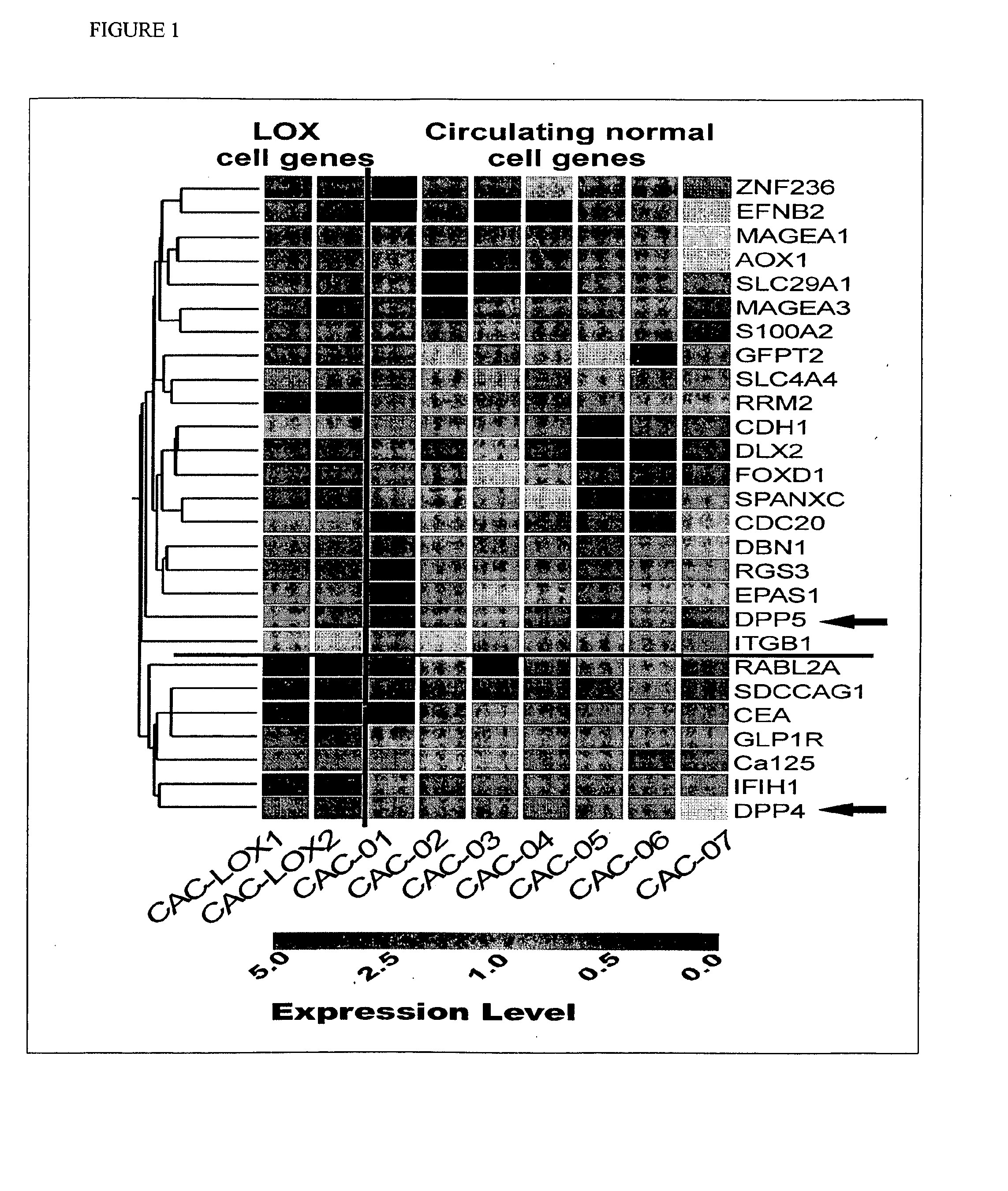Gene expression signatures in enriched tumor cell samples
a gene expression and tumor cell technology, applied in the field of gene expression signatures in enriched tumor cell samples, can solve the problems of antibody entail a substantial loss of metastatic tumor cells, cancer is not sufficiently distinguished from normal cells, and ctcs are rar
- Summary
- Abstract
- Description
- Claims
- Application Information
AI Technical Summary
Benefits of technology
Problems solved by technology
Method used
Image
Examples
example 1
Gene Expression Signatures of Metastatic Tumor Cells in Blood of Patients with Malignant Solid Tumors
[0232]Patients and Healthy Blood Donors. Prior to treatment, cancer patients, including patients with colorectal and breast cancers, as well as healthy individuals were admitted to the study after written, informed consent was obtained. Fresh blood samples and relevant pathological data were obtained from the Stony Brook University Medical Center and the Veteran Administration Medical Center at Northport, N.Y., respectively. The clinical follow-up data included tumor type and stage, as assessed by the treating physician.
[0233]Blood Sample Preparation. Between 4 to 16 ml (median=8 ml) of peripheral blood were collected in Vacutainer™ tubes (Becton Dickinson, Franklin Lakes, N.J.; green top, lithium heparin as anticoagulant). Blood samples were delivered to the laboratory at room temperature within one to four hours from collection, and processed immediately. The CAM-initiated rare cel...
example 2
Gene Expression Signature of Metastatic Tumor Cells in Patients with Ovarian Cancer
[0260]Here, we describe the enrichment of metastatic tumor cells in ascites (MTCA), which contained greater than 25% of cells positive for cytokeratin and CA125, from ovarian cancer patients using a novel collagen adhesion matrix (CAM) method that isolated cells invading collagen. Using the RNA extracted from MTCA fractions and comparing it with the RNA extracted from primary tumor cells in the ovary (PTC), we identified a MTCA signature, in which 21 upregulated genes were common between primary and metastatic tumor cells and 16 genes were upregulated only in metastatic tumor cells. We then selected five genes from the former and four genes from the latter to test in a similar set of samples using real-time RT-PCR. The MICA signature was used to distinguish samples of metastatic tumor cells in ascites from late stage primary tumor cells, and cells from benign and early stage ovarian tumors. Finding no...
example 3
[0272]To validate the 17-candidate colorectal cancer CTC marker genes (DTR, PSCA, MUC3A, THRA, CD79B, NOTCH1, MUCDHL, NEUROG2, MDS028, KRT18, FOLH1, CD44, FCER2, SCF, CD7, SOX1 and TEKT3), the CTC score of a sample was used in the testing set of cellular samples that consists of 9 normal, 9 colorectal cancer and 20 breast cancer (FIG. 16B-C). The CTC score of a sample was determined as the percentage of the 17-candidate colorectal cancer CTC marker genes that exhibited upregulated expression. CTC scores for the 9 normal samples were 0-12%, whereas the CTC scores of the 9 colorectal cancer samples were 94-100% and the 20 breast cancer samples were 24-100%. There was a significant difference of the mean±standard error CTC score between normal and cancer patients with colorectal and breast tumor types (FIG. 16C): 2.67±1.45 in normal samples as compared with 98.67±0.88 in colorectal cancer samples and 69.20±5.53 in breast cancer samples (p-value<0.0001). CTC scores varied significantly ...
PUM
| Property | Measurement | Unit |
|---|---|---|
| Ficoll Paque density gradient centrifugation | aaaaa | aaaaa |
| diameter | aaaaa | aaaaa |
| epithelial cell adhesion | aaaaa | aaaaa |
Abstract
Description
Claims
Application Information
 Login to View More
Login to View More - R&D
- Intellectual Property
- Life Sciences
- Materials
- Tech Scout
- Unparalleled Data Quality
- Higher Quality Content
- 60% Fewer Hallucinations
Browse by: Latest US Patents, China's latest patents, Technical Efficacy Thesaurus, Application Domain, Technology Topic, Popular Technical Reports.
© 2025 PatSnap. All rights reserved.Legal|Privacy policy|Modern Slavery Act Transparency Statement|Sitemap|About US| Contact US: help@patsnap.com



